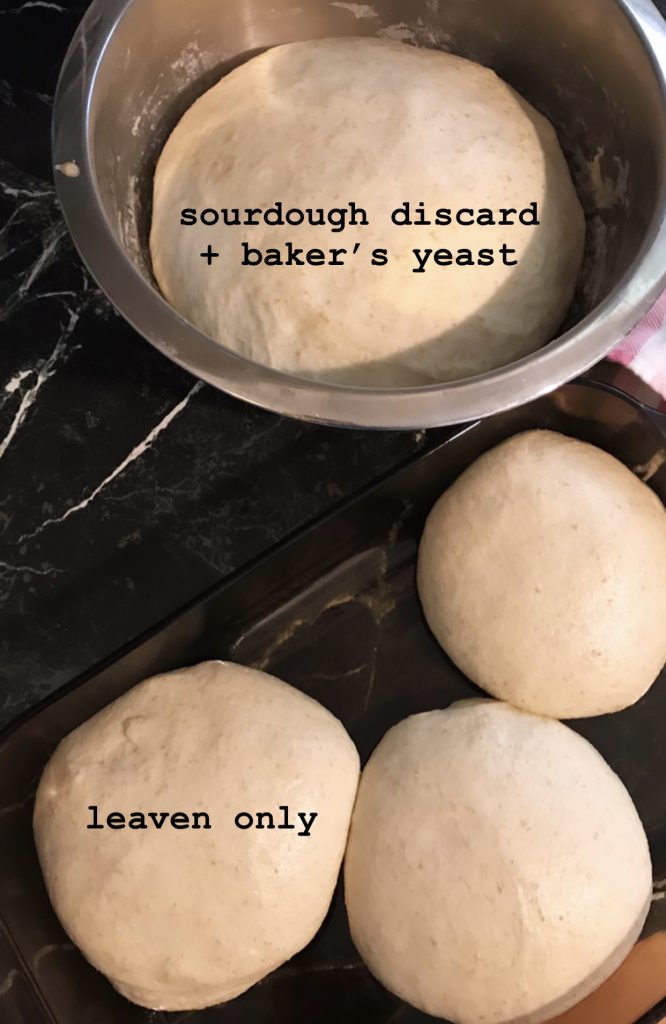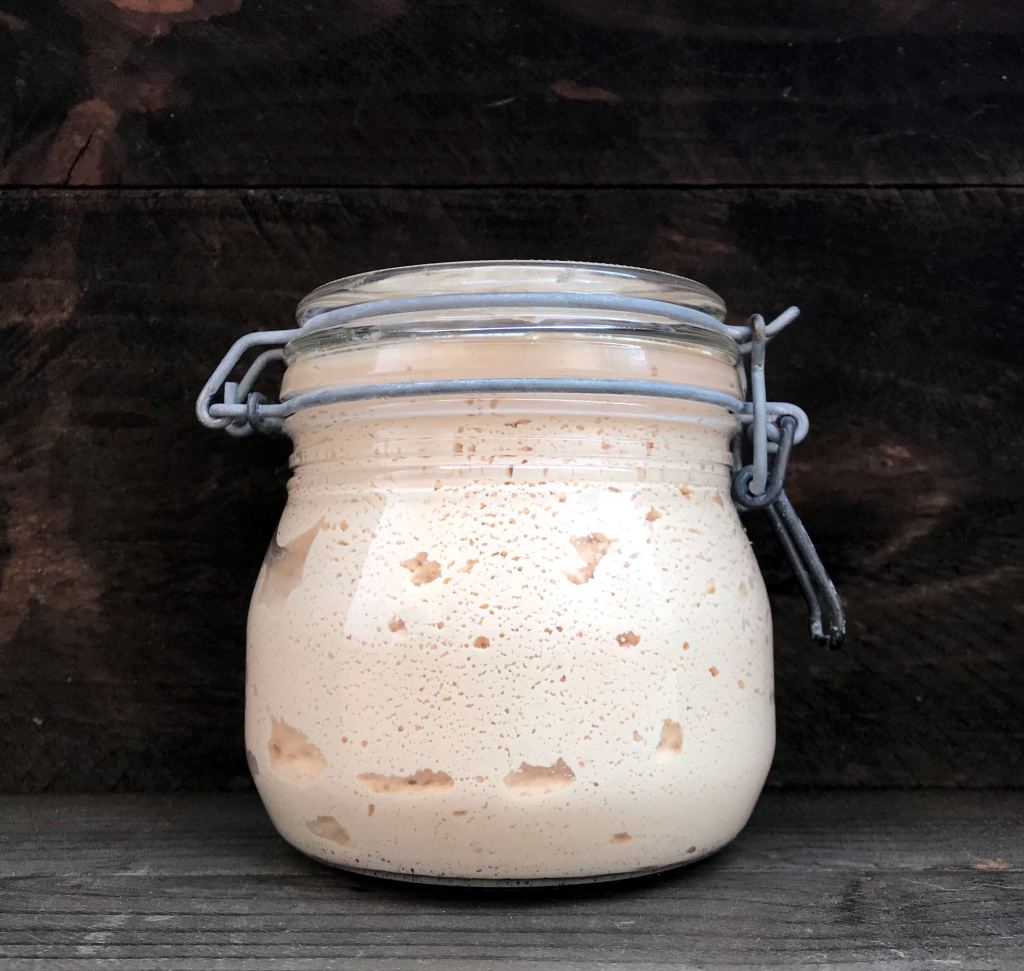Updated 06/06/23
If you’ve hopped on the sourdough pandemic bandwagon, first of all, welcome. And whether you’ve baked the bread or quick pancakes or the world’s simplest chocolate cake, you likely now understand what all the fuss is about. But you still may wonder just what else you can bake with either your bubbly starter or the discard left over from feeding it (but probably both).
Fortunately you can substitute sourdough starter for a portion of the flour and water (or possibly juice or milk) called for in many non-sourdough recipes—quick breads, yeast breads, muffins, tortillas, focaccia, pizza and more.
A note of caution: You can’t sub in sourdough starter for EVERY recipe you come across. But for many, it works very well.
The types of recipes that work best for a starter swap
Because it contains water, sourdough starter works well as an addition to very wet recipes, like doughs and batters, although my daughter Charlotte did make sourdough cookies on the weekend with discard and reported back that they tasted delicious. (I’ve added those to my long to-blog list.)
Generally however, if a recipe doesn’t call for liquid—such as a classic chocolate chip cookie recipe—in order to compensate for the water present in the starter that you add, you’ll have to substantially tweak the original recipe.
As you tweak your recipes, keep in mind that if you remove some juice to compensate for the additional water of a starter, the result will taste less sweet. If you remove some milk, the finished product will have a drier consistency without the fat from the milk that’s no longer in it.
For this post, I’ve chosen a simple, foolproof recipe to adapt—pizza dough.
Do the math
Bob wants to add 1 cup of sourdough discard to his favorite pizza dough recipe for a bit of sourdough flavor. He uses a 100 percent hydration sourdough starter, meaning his starter contains equal parts flour and water—by weight.
Bob doesn’t own a scale. He wants to try cooking a few things with his new starter before even thinking about buying more stuff. Bob does, however, have this blog post and the following approximate conversions to which he can refer:
Sourdough starter substitute
250 grams (1 cup) stirred down sourdough starter
Replaces
125 grams (1 scant cup) flour
125 grams (½ cup plus 2 teaspoons) water
Over time, starter does become runnier as the bacteria and yeast eat the sugars, break down the starter and excrete alcohol, but let’s just keep things simple for Bob. Reading about himself in this post he’s following for his dough has confused him enough as it is.
By the way, when a recipe calls for a certain volume (cups) of sourdough starter rather than weight (grams), stir the starter down to remove the air bubbles before measuring. The air bubbles can easily double the volume—at least. One cup of bubbly starter can deflate to less than ½ cup after stirring.
Now let’s see how Bob will add his 1 cup of discarded sourdough starter to his favorite pizza recipe.
Sourdough discard pizza
Below are the ingredients in Bob’s favorite pizza dough, based on this recipe.
- 2¾ to 3 cups all-purpose flour
- 1 teaspoon salt
- 2 teaspoons active dry yeast
- 1 teaspoon sugar
- 1 cup warm water (105° to 115°F)
- 2 tablespoons olive oil plus more to grease the proofing bowl
Bob will adjust the above list of ingredients as follows: he’ll add 1 cup of discard and remove both a scant cup of flour and a generous ½ cup of water. His edited list of ingredients now looks like this, with the changes shown in bold:
- 1¾ to 2 cups all-purpose flour
- 1 teaspoon salt
- 2 teaspoons active dry yeast
- 1 teaspoon sugar
- scant ½ cup warm water (105° to 115°F)
- 2 tablespoons olive oil plus more to grease the proofing bowl
- 1 cup discarded sourdough starter, brought to room temperature
Commercial yeast versus wild yeast

I added sourdough discard to this dough for flavor, not for leavening, hence I kept the commercial baker’s yeast in the recipe. The sourdough starter you remove for feedings and store in the refrigerator does not contain enough yeast to leaven dough. But it tastes good and has fermented for a long time, making it more easily digestible.
I included a naturally leavened sourdough pizza recipe in my book, which will be published April 13th, 2021. (You can learn more about the book and preorder here.)
I prefer the very chewy naturally leavened dough. My daughter MK has a medical condition that makes chewing difficult so she prefers this less chewy sourdough discard version. We both love that this pizza dough uses up an entire cup of sourdough discard.
Pizza and french fries

MK made a batch of very runny hummus last week. She worried that she had wasted beans, expensive olive oil and other ingredients. To salvage it, we spread it on the pizza. The heat of the oven thickened up the hummus (as it will all sauces), creating the perfect consistency. If you want to try this, thin out your hummus with the water you cook the chickpeas in.
I thought potatoes would go well with the hummus (plus we had very few vegetable toppings and use whatever we have on hand during quarantine). I parboiled a peeled potato for about 10 minutes, sliced it thinly, spread the slices across the pizza, brushed them with olive oil and sprinkled them with salt. So I essentially topped this pizza with french fries. So good! We made this pizza a few times and now need more extra-runny hummus for more pizza.

Lately, I’ve been topping my pizza dough with cultured cashew cheese. You can find the recipe for that here.
Sourdough Discard Pizza
Ingredients
- 2 to 2⅛ cups all-purpose flour plus more for kneading and shaping
- 1 teaspoon salt
- 2 teaspoons active dry yeast
- 1 teaspoon sugar
- ¼ cup warm water 105° to 115°F
- ¼ cup hot water
- 1 cup unfed discarded starter
- 2 tablespoons olive oil plus more for greasing the proofing bowl
- cornmeal for sprinkling
- pizza toppings
Instructions
- Combine the flour and salt in a large mixing bowl. Use a wire whisk or fork to combine.
- In a medium bowl or measuring cup, combine the yeast, sugar and ¼ cup warm water. Set aside for 10 to 15 minutes, until bubbly and foamy.
- In a smaller bowl or measuring cup, combine the sourdough discard and ¼ cup hot water. (This will help warm up the cold discard.)
- Once the yeast mixture has become bubbly and foamy, stir in the olive oil and discarded starter.
- Add the liquid ingredients to the dry ingredients and stir to combine.
- Knead the dough in the bowl a few times to incorporate the flour. Add more flour if the dough is extremely sticky.
- Turn the dough out onto a floured surface and knead for 4 or 5 minutes.
- Grease the bowl with olive oil, return the dough to it and cover with a towel. Let proof for about 1½ hours, or until the dough has doubled in size.
- Fifteen minutes before finishing proofing the dough, preheat the oven at 500°F. If using a baking stone to bake the pizza, place it in the center of the oven to heat. If you don't use a pizza stone, bake your pizza in a large cast-iron pan or on a baking sheet (these do not need to be heated).
- Punch down the dough and divide it into two halves. If you want to bake only one pizza, put one ball in the refrigerator in a container and use it within 2 to 3 days. The dough also freezes well. Remove it from the freezer several hours before you make the pizza or thaw it out overnight in the refrigerator.
- Roll the dough into a ball. On a lightly floured surface, flatten it out with your knuckles into a circle about 5 inches in diameter. Rest the dough on the back of your fists, hands together. Move your hands apart while simultaneously tossing the dough a few feet in the air. Catch the spinning dough on the back of your fists and repeat until you've formed a circle 9 or 10 inches in diameter. Or if you prefer, roll out the dough with a rolling pin to your desired thickness.
- Sprinkle the pizza peel, cast-iron pan or cookie sheet with cornmeal. Place the formed dough on the cornmeal and spread on your desired toppings. With a quick flick of the wrist, slip the pizza from the peel onto the baking stone. Or place the cast-iron pan or baking sheet in the oven.
- Bake for 8 to 10 minutes, until the edges have lightly browned. Broil for minute longer to brown the top. If using the baking stone, slide the pizza peel under the pizza to remove it from the oven.
Notes
Check out my award-winning cookbook!
- Taste Canada silver for single-subject cookbooks
- Second-place Gourmand cookbook award in the category of food waste
- Shortlisted for an award from the International Association of Culinary Professionals
Learn more about my book here.




You have a book coming???? YAY!
Thank you Jane. I do! I will post it all over closer to the pub date 😀
~ Anne Marie
1 tablespoon dry yeast? Or 1 teaspoon?
Hi Marina,
That is more yeast than necessary. I’ve updated it to 2 teaspoons.
Enjoy!
Anne Marie
what temperature do you cook your pizza? i don’t see it on the recipe?
Hi Steph,
I bake it at 500 degrees Fahrenheit.
Enjoy!
Anne-Marie
I made it and it worked really well! I’m not a great pizza maker and it still turned out nice!
I’m so glad you liked it, Anita 🙂
~ Anne-Marie
[…] Este artigo foi baseado em uma publicação em inglês. Clique aqui para acessar o conteúdo originário. […]
Can I combine these in a bread machine on dough setting?
Hi Michelle,
I haven’t tried that but I think it should be fine. The sourdough discard mostly adds flavor, especially if it’s older. So this is basically a regular yeast crust.
Enjoy!
Anne-Marie
It looks to me like a lot of dry yeast, if l use sourdough (very active, started it in march) can I replace by more sourdough? I am not such a fan of dry yeast, cause I don’t like the smell and taste🙊…
Just wanted to say thanks for creating this recipe!! The pizza is AMAZING I also use this dough to make cinnamon rolls! 🙂
This recipe is amazing, thank you!
Thank you! I’m so glad you like it 🙂
~ Anne-Marie
THANK YOU! Your recipes are excellent! Not only tasty, but very well written with lots of description so that one can easily follow the procedure and understand it. I have always been into zero waste and am glad to see many more newer enthusiasts out there. Back in my day, those of us with discarded starter didn’t have too many recipes beyond the waffles, pancakes, etc.
Can I use this pizza dough to my breadsticks? Pam
What a great idea, Pam! I don’t see why that wouldn’t work. They’d be really tasty brushed with olive oil and sprinkled with some garlic granules. I’m going to have to try this. Thank you for the idea.
~ Anne-Marie
Hello! Have you tried freezing the prepared dough? I’m curious if I could mix the dough up ahead of time and then freeze it to cook at a later time. Thanks!
Hi Erin,
Yes, I have! It works well. I take it out of the freezer a few hours before I bake it. It’s very convenient.
Enjoy!
Anne-Marie
At what point in the recipe do you freeze it?
Hi Juliane. Freeze it after it rises and you punch it down. I put it in a glass container with a bit of room to expand, just in case.
When you remove dough from the fridge should you allow it to come to room temp or can you work with it right away?